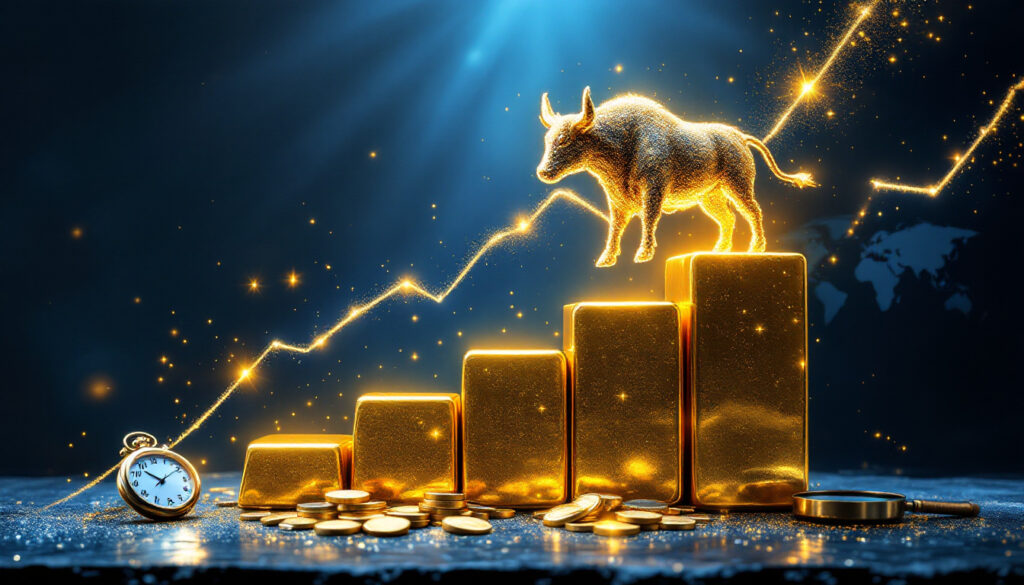What Makes This a Precious Metals Bull Market?
Current Market Indicators
Gold has established strong upward momentum, recently surpassing $3,000 per ounce, marking a significant technical and psychological threshold. This milestone has attracted generalist investors who were previously absent from the precious metals sector, broadening the market's participant base.
Market leadership is visibly shifting from gold to silver, which is a classic pattern observed in previous precious metals bull markets. This rotation typically signals a maturing bull market with substantial room for continued growth.
Historical patterns suggest we're in the early-to-middle phase of this silver and gold bull market cycle. When comparing to previous cycles, the current fundamentals point to a potentially more sustained and powerful advance than those seen in recent decades.
Historical Context of Precious Metals Bull Markets
The 1970s bull market witnessed gold's dramatic rise from $35 to $200 per ounce, followed by a correction to $100, before ultimately surging to $850. This pattern of advance-retreat-explosion is characteristic of precious metals bull markets and mirrors current market behavior.
Rick Rule, former CEO of Sprott Asset Management, brings perspective as a veteran of three substantial precious metals bull markets during his multi-decade career. His experience spans the 1970s, early 2000s, and current cycles, providing valuable historical context.
Silver has historically demonstrated greater volatility and upside potential than gold as a hedge in established bull markets. During the 1970s, while gold increased approximately 24 times, silver surged from $1.50 to $50, representing a much larger percentage gain.
Why Is Silver Poised to Outperform Gold?
Silver's Unique Market Dynamics
Silver markets exhibit extraordinary leverage, with daily futures trading volume representing 100-200 times the available physical silver. This disconnect between paper and physical markets creates the potential for explosive price movements when investor sentiment shifts.
Silver demonstrates higher volatility than almost any other commodity, making it both risky and potentially highly rewarding. Price swings of 50% are not uncommon even during overall bull markets, requiring strong conviction from investors.
Short positions in silver have been maintained by large financial institutions for decades, creating a coiled spring effect as market momentum builds. As Rule colorfully notes: "A short position in silver could deliver a religious experience to the wrong side of the trade."
Market Manipulation Factors
Large financial institutions have developed sophisticated methods for maintaining short positions, including creating short ladders across multiple time frames that allow them to manage risk while suppressing prices.
Wall Street traders have collectively shorted precious metals for approximately 40 years during the dollar's ascendancy. This established pattern may be reaching its conclusion as fiscal and monetary policies threaten currency stability.
The industrial demand component of silver (approximately 50% of annual consumption) creates a fundamentally different supply-demand dynamic compared to gold, which is primarily held for investment purposes.
How Should Investors Position for a Precious Metals Bull Market?
Physical Metal Allocation Strategies
One "monster box" (500 ounces) of silver represents a meaningful position for individual investors looking to maintain purchasing power through economic turmoil. At current prices, this approximately $15,000 investment provides tangible inflation protection.
Investors must prepare for significant volatility, with possible 50% drawdowns even during bull markets. Historical patterns suggest these corrections often occur just before the most dramatic upward moves.
Current premiums for physical silver are at multi-year lows—approximately $3.49 over spot for Canadian Maple Leafs—making entry points attractive compared to previous cycles when premiums expanded dramatically during supply shortages.
Precious metals primarily serve to maintain purchasing power rather than creating new wealth. As Rule emphasizes, "Gold and silver don't make you rich; they keep you from becoming poor when governments debase currencies."
Portfolio Considerations
Having a lifestyle within your means is equally important as owning precious metals. Financial stability through reduced debt and sustainable spending provides resilience regardless of market movements.
Platinum presents an interesting speculative opportunity at current prices (less than 1/3 the price of gold). Supply constraints from aging South African mines (representing 60% of global production) and continued automotive catalyst demand create favorable fundamentals.
Gold mining stocks may outperform uranium investments in the near term (2025), though both sectors show promise. The HUI/Gold ratio remains at historically low levels (0.15), suggesting mining equities are undervalued relative to bullion.
Diversification across physical metals and mining investment strategies provides balanced exposure to different aspects of the precious metals complex, allowing investors to capture both preservation of capital and growth potential.
When Will This Precious Metals Bull Market End?
Key Indicators to Watch
The federal budget balance remains dramatically out of alignment, with deficits exceeding 5% of GDP even during periods of economic growth. Until fiscal discipline returns, precious metals will likely maintain their appeal as alternative assets.
Current fiscal policies show no capacity for handling the estimated $100 trillion in unfunded entitlement liabilities facing the United States. This structural issue represents a multi-decade tailwind for precious metals.
Interest rates on US Treasury bonds remain significantly below real inflation, which Rule estimates at 7.5-8.5% when measured against everyday expenses rather than official CPI figures.
Federal debt has surpassed GDP and continues to grow, with no political will evident for reducing spending. According to Rule, these conditions suggest maintaining gold positions for the foreseeable future—potentially decades.
Psychological Market Signals
Market tops typically occur when mainstream financial media embraces precious metals without reservation. The current coverage remains skeptical, suggesting substantial upside potential remains.
Wall Street analysts who "can actually spell gold" are just beginning to appear, with major investment banks gradually increasing price targets and allocation recommendations. This represents middle-stage bull market behavior rather than euphoric endpoints.
True bull market peaks feature widespread public participation, with dental offices and hair salons becoming sources of investment advice. The current market shows minimal retail enthusiasm compared to historical manias.
Experienced investors should prepare to look for alternative undervalued assets when precious metals become overvalued. Previous cycles saw smart money rotating from overbought metals into bombed-out equities or other depressed sectors.
How Does Currency Debasement Drive Precious Metals?
Government Fiscal Policies
Federal deficits and expansionary monetary policy continue to erode the dollar's purchasing power. The post-COVID increase in money supply by approximately $8 trillion represents one of history's most dramatic monetary expansions.
In the 1970s, the US dollar lost 75% of its purchasing power over the decade as inflation ravaged household finances. Current conditions of high debt, persistent deficits, and unfunded liabilities create similar pressures.
Taxation and currency debasement represent different forms of wealth extraction, with debasement affecting all currency holders regardless of tax bracket. Precious metals offer partial immunity to this "silent tax."
The inability of governments to address structural fiscal imbalances has historically preceded currency crises. Gold and silver's monetary role becomes increasingly relevant as confidence in fiat money erodes.
Alternative Currency Systems
Central Bank Digital Currencies (CBDCs) pose potential risks to financial privacy and autonomy. Programmable features like expiration dates or spending restrictions could accelerate flight to tangible assets like precious metals.
Gold-backed digital currencies may emerge as alternatives to government currencies within 2-3 years. These systems would combine the efficiency of digital transactions with the stability of physical metal backing.
Physical gold and silver will likely serve as alternative mediums of exchange in any monetary reset scenario. Their 5,000-year history as money provides confidence during periods of currency uncertainty.
Battle Bank and similar institutions aim to provide services that allow borrowing against physical precious metals, creating liquidity without forcing liquidation—a hybrid approach bridging traditional and alternative financial systems.
What Role Will Precious Metals Play in a Global Reset?
Potential Reset Scenarios
Digital currencies with expiration dates and usage restrictions could inadvertently push populations toward precious metals and other tangible assets that preserve autonomy and purchasing power.
Physical gold and silver may become preferred mediums of exchange outside official systems, similar to their role in countries experiencing high inflation or currency controls.
A comprehensive understanding of global commodities insights is essential for investors navigating this market. A gold-backed digital token could emerge as a viable alternative currency within 2-3 years, potentially from private sector initiatives rather than government programs.
Government confiscation risks appear limited in the US compared to the 1933 gold seizure, partly due to practical considerations including widespread private ownership of firearms and changed political conditions.
Protecting Wealth Internationally
Legal methods exist for moving "real money" abroad through proper documentation and compliance with reporting requirements. Transparency rather than concealment provides sustainable protection.
Filing appropriate financial disclosure forms (FINCEN) while maintaining transparency represents the prudent approach to international diversification. Rule emphasizes that secret accounts create more problems than they solve.
Multiple jurisdictional diversification of assets provides resilience against country-specific risks, whether regulatory, political, or economic.
Physical precious metals stored outside one's home country can provide additional security against localized crises, with Singapore, Switzerland, and certain Canadian provinces offering strong property rights protections.
FAQ: Common Questions About Precious Metals Investing
How volatile will silver be during this bull market?
Investors should prepare for extreme volatility, with potential 50% drawdowns even during the overall uptrend. The 1974-1975 correction saw silver fall by more than half before resuming its upward trajectory toward the 1980 peak.
Silver is historically more volatile than gold, which makes it both higher risk and potentially higher reward. This volatility stems from its smaller market size, dual industrial/investment demand, and greater leverage in futures markets.
Should I invest in physical metals or mining stocks?
Both have their place in a well-structured portfolio. Physical metals provide insurance against systemic risk, while quality mining stocks offer leverage to rising metal prices, potentially multiplying returns during bull markets.
For 2025 specifically, gold and silver miners may outperform other resource sectors like uranium, though diversification across natural resource categories remains prudent. The GDXJ junior miners ETF has returned approximately 45% in 2025 compared to gold's 25% advance.
What about platinum as an investment?
Platinum presents a speculative opportunity trading at less than 1/3 the price of gold—a historical anomaly considering platinum's greater rarity and traditionally higher pricing.
Supply constraints primarily from South Africa (where aging infrastructure limits production) and Russia (facing export restrictions) combine with continued demand from catalytic converters to create favorable supply-demand dynamics.
How will I know when the bull market is ending?
Watch for widespread public participation, mainstream financial media enthusiasm, and a reversal of the fundamental factors driving precious metals (balanced budgets, interest rates above inflation, etc.).
The psychological top typically features ubiquitous advertisements for precious metals, dramatic price predictions from non-experts, and a sense that "this time is different." Until these conditions materialize, the silver and gold bull market likely remains intact.
Expert Investment Opportunities in the Natural Resource Sector
The Rule Investment Media Approach
Portfolio reviews available at ruleinvestmentmedia.com provide personalized analysis of investors' holdings, with stocks ranked from 1-10 with specific comments tailored to individual circumstances.
The focus remains exclusively on natural resource stocks, avoiding trendy sectors like cryptocurrency, cannabis, or technology where Rule lacks specialized expertise.
Opportunities to learn from industry veterans who have built multi-billion dollar companies come through conferences, publications, and direct communications with seasoned operators.
Rule's decades of experience in bear and bull markets across multiple commodities provides context often missing from mainstream financial analysis.
Upcoming Natural Resource Investment Conference
The conference features speakers like David Stockman (former Reagan budget director) who bring macroeconomic perspectives to resource investing.
Presentations from industry insiders with decades of experience offer insights not available through conventional financial media.
For those seeking to understand the foundational aspects of the sector, a beginner's mining guide can be invaluable before attending such conferences.
All exhibitors are personally vetted by Rick Rule, ensuring a higher quality standard than typical investment conferences where booth space is sold without discrimination.
Both in-person attendance and livestream options are available with a full money-back guarantee for those dissatisfied with the content.
One attendee highlighted the unique value: "Following Robert Freedelland and then Ross Bey around your exhibit floor, seeing what booths they stopped in front of and lurking and hearing what questions they asked was worth more than the price of admission."
Note: This article contains information about precious metals investments and market dynamics as discussed by Rick Rule, former CEO of Sprott Asset Management. For a deeper understanding of precious metals, consider reviewing recent gold market analysis that examines current trends. The content is educational in nature and should not be considered direct investment advice. Investors should conduct their own research and consult with financial professionals before making investment decisions.
Ready to Find Tomorrow's Mining Discoveries Today?
Discovery Alert's proprietary Discovery IQ model instantly notifies investors of significant ASX mineral discoveries, turning complex data into actionable investment opportunities before the broader market reacts. Visit the Discovery Alert discoveries page to understand how major mineral discoveries can deliver exceptional returns, and start your 30-day free trial to position yourself ahead of the next precious metals opportunity.




